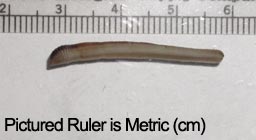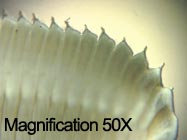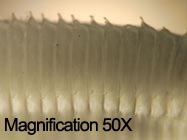
Monthy Case Studies - 2001
Case #54 - February, 2001
A public health laboratory in the southwestern United States submitted a segmented worm to CDC's reference laboratory for identification. A woman found the worm in the bathtub after her 5-year-old son had finished bathing. She stated that her son had complained of abdominal pain and occasional constipation. The whole worm is shown in Figure A. Low-power microscopic views of different sections of the worm are shown in Figures B and C. What is your diagnosis? Based on what criteria?

Figure A

Figure B

Figure C
Answer to Case #54
The worm submitted was not a parasite. It belongs to the family Lumbricidae, commonly known as earthworms. This could have been a spurious event where the worm was swallowed and passed through the gut, but more likely represents an incidental finding of the earthworm in the bathtub.
Diagnostic features observed were:
- a segmented body. The external morphology suggested segmentation, but the internal structures were not repetitive like those of tapeworms.
- the presence of paired rows of setae (bristles), that earthworms use for burrowing and locomotion. Parasitic nematodes do not have such structures.
The earthworm in this case would most likely be confused with Ascaris lumbricoides. It is not uncommon for A. lumbricoides worms to migrate from the rectum or, on rare occasions, from the mouth or nose. Because developing and mature A. lumbricoides worms are variable in size and males are considerably smaller than females, size cannot be the sole factor used to rule out a diagnosis of ascariasis. However, even with some distortion caused by fixation, A. lumbricoides does not appear segmented. Another diagnostic feature of A. lumbricoides is the presence of the three typical ascarid lips.
More on: Artifacts and Pseudoparasites
Images presented in the monthly case studies are from specimens submitted for diagnosis or archiving. On rare occasions, clinical histories given may be partly fictitious.
 ShareCompartir
ShareCompartir


